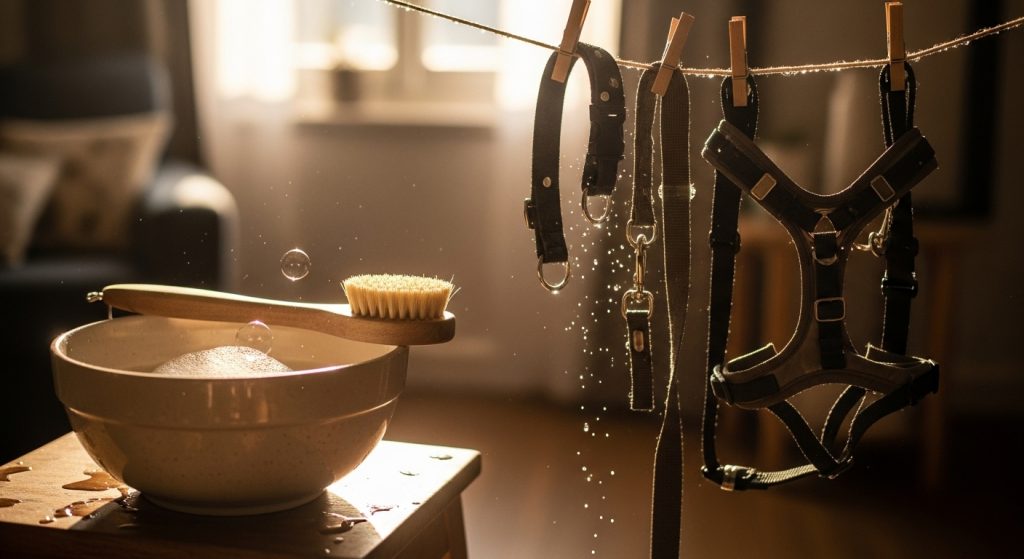Dogs bring us endless love—and a fair share of mud, drool, and fur. Over time, their collars, toys, leashes, and beds can collect dirt, bacteria, and unpleasant odors. Not only can these smells make your home less inviting, but they can also cause skin irritations or even infections for your furry friend.
Keeping your dog’s gear clean isn’t just about aesthetics—it’s about health, hygiene, and comfort. Whether you have a playful puppy or a senior dog, establishing a consistent cleaning routine helps protect both your pet and your home environment.
Let’s dive into the simple yet effective ways to keep all your dog’s essentials spotless and fresh.
Cleaning Collars, Harnesses, and Leashes the Right Way
Dog collars and leashes are exposed to sweat, drool, rain, and outdoor dirt daily. They’re often overlooked, yet they’re some of the dirtiest items your pet owns.
Step-by-Step Guide to Cleaning
-
Fabric Collars & Leashes:
Mix warm water with a bit of pet-safe detergent or baking soda. Soak the items for 15–20 minutes, then gently scrub with a soft brush. Rinse thoroughly and let them air dry completely before use. -
Leather Collars:
Wipe with a damp cloth, avoiding excessive water. Then apply a leather conditioner to prevent cracking or drying. Never use bleach or alcohol-based cleaners, as these can damage the leather. -
Nylon Harnesses:
Place them in a mesh laundry bag and wash on a gentle cycle. Avoid dryers—air drying maintains their shape and elasticity.
Odor-Fighting Tips
-
Add a few drops of white vinegar to your rinse water—it’s a natural deodorizer and antibacterial agent.
-
Keep a small spray bottle with diluted vinegar and water for quick wipe-downs after outdoor adventures.
Common Mistakes to Avoid
-
Don’t leave collars or leashes damp—it encourages mildew.
-
Avoid using human shampoos or perfumed detergents, which can irritate your dog’s skin.
Pro tip: Rotate between two sets of gear—this ensures one is always clean and dry.
Deep Cleaning Dog Beds, Blankets, and Crate Pads
Your dog’s bed is where they spend hours resting, dreaming, and sometimes drooling. Over time, it collects hair, dander, dirt, and odor-causing bacteria—especially if your pet enjoys outdoor adventures.
Regular Cleaning Routine
-
Vacuum First: Remove loose fur and dirt before washing.
-
Check the Label: Most beds and blankets have care instructions—follow them carefully.
-
Wash with Mild Detergent: Use a fragrance-free detergent to avoid skin irritation.
-
Add Baking Soda: It helps eliminate stubborn odors.
-
Dry Completely: A sunny spot or tumble dry on low heat ensures no moisture remains.
Odor Prevention Between Washes
-
Sprinkle baking soda weekly, then vacuum it up after 15 minutes.
-
Use washable covers and rotate them regularly.
-
Air the bed outside once a week to refresh it naturally.
Special Considerations
For senior dogs or those prone to accidents, consider waterproof liners to prevent liquid absorption into the foam base. Replace beds every 6–12 months depending on use and odor buildup.
Pro tip: Invest in machine-washable, quick-dry fabrics—they’ll save you time and extend the lifespan of your dog’s bedding.
Keeping Toys, Bowls, and Grooming Tools Fresh
While we often think about washing bedding or leashes, dog toys and bowls are major odor sources that can harbor bacteria if not maintained. The same goes for grooming brushes and combs that touch your dog’s skin frequently.
Cleaning Dog Toys
-
Rubber & Plastic Toys:
Soak in a mix of warm water and mild soap for 15 minutes. Scrub away residue with an old toothbrush and rinse well. -
Fabric & Plush Toys:
Check labels—most can go in the washing machine using a gentle cycle. Add a teaspoon of vinegar for odor control and skip the dryer to avoid damage. -
Rope Toys:
These can be microwaved for 1 minute after soaking in water to kill bacteria (only if they contain no metal).
Cleaning Food and Water Bowls
-
Wash daily with hot, soapy water—just like human dishes.
-
For a deeper clean, soak bowls in vinegar for 10 minutes weekly to remove mineral deposits.
-
Stainless steel or ceramic bowls are best for resisting bacteria and odors. Avoid plastic, which traps smells and scratches easily.
Maintaining Grooming Tools
-
Remove hair from brushes after every use.
-
Wash metal tools like nail clippers or combs with warm soapy water and dry thoroughly to prevent rust.
-
Store everything in a dry, ventilated area to avoid mildew.
Pro tip: Mark a specific “dog gear wash day” on your calendar—consistency prevents odors before they start.
A Fresh Routine for a Happy Pup
Keeping your dog’s gear clean and odor-free doesn’t have to be complicated. With a few simple habits—like washing regularly, using natural deodorizers, and checking for wear—you’ll keep your pet healthy, your home fresh, and your gear lasting longer.
Remember: your dog depends on you for comfort and hygiene. A clean leash, cozy bed, and fresh-smelling toys aren’t just nice—they’re essential to your dog’s well-being.
So next time you catch a whiff of that mysterious dog smell, take it as a cue to freshen things up. Your dog (and your nose) will thank you!




